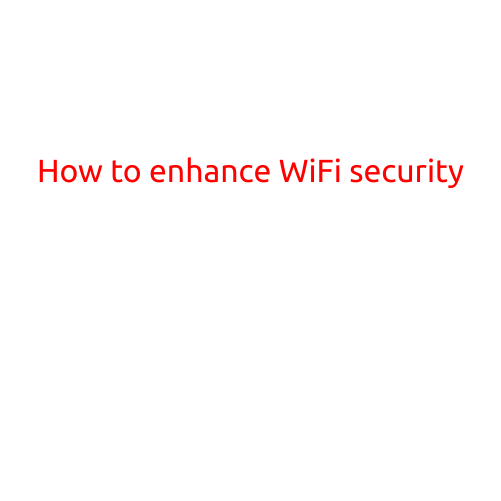
How to Enhance WiFi Security
In today’s digital age, WiFi security is a top concern for individuals and businesses alike. With the increasing reliance on wireless networking, it’s essential to ensure that your WiFi connection is secure and protected from unauthorized access. In this article, we’ll provide you with a comprehensive guide on how to enhance WiFi security and protect your network from potential threats.
Change Your Router’s Defaults
One of the simplest ways to enhance WiFi security is to change the default administrator password and network name (SSID) of your router. These defaults are often publicly available and can be easily accessed by hackers. Change them to strong and unique passwords that are difficult to guess.
Use WPA2 Encryption
WPA2 (Wi-Fi Protected Access 2) is the latest encryption standard and is widely supported by most devices. WPA2 uses Advanced Encryption Standard (AES) with a 128-bit key, which provides strong encryption and secure data transmission. Make sure your router supports WPA2 and that all your devices are configured to use it.
Use a Strong Network Password
A strong network password is essential for securing your WiFi connection. Use a combination of letters, numbers, and special characters to create a password that is at least 12 characters long. Avoid using easily guessable passwords such as your name, birthdate, or common words.
Use a Guest Network
A guest network allows guests to access your WiFi network while separating their traffic from your main network. This feature helps to prevent malware and other threats from spreading to your devices. You can also limit guest network access to specific devices and set a separate password for the guest network.
Use a Firewall
A firewall is a crucial component of WiFi security that monitors incoming and outgoing network traffic. Make sure your router has a built-in firewall and enable it to block unknown or suspicious traffic.
**Use a Network Segmentation
Network segmentation involves isolating certain devices or segments of your network from the rest of the network. This helps to prevent a security breach in one area from spreading to other areas of the network. You can use virtual local area networks (VLANs) or separate routers to segment your network.
Regularly Update Your Router’s Firmware
Regular firmware updates are essential for maintaining your router’s security. Firmware updates often include bug fixes and security patches that can help protect your network from known vulnerabilities. Check your router’s manufacturer website for available updates and follow their instructions to update your firmware.
Use a VPN
A Virtual Private Network (VPN) creates a secure and encrypted connection between your device and the VPN server. This helps to protect your data and prevent eavesdropping when using public WiFi networks.
Monitor Your Network Activity
Monitoring your network activity is essential for detecting and preventing security breaches. Use network monitoring tools such as Wireshark or Xerox to monitor your network traffic and identify suspicious activity.
Implement a Least Privilege Policy
A least privilege policy involves assigning the minimum level of access required for your devices and users to access your network. This helps to prevent unauthorized access and minimize the damage caused by a security breach.
Conduct Regular Security Audits
Conducting regular security audits is essential for identifying vulnerabilities and weaknesses in your network. Use security auding tools such as Nmap or Nessus to scan your network and identify potential vulnerabilities.
Stay Informed and Updated
Stay informed about the latest WiFi security threats and vulnerabilities. Follow your router’s manufacturer for the latest security updates and best practices for securing your WiFi network.
By following these simple steps, you can significantly enhance WiFi security and protect your network from potential threats. Remember to always stay informed and up-to-date with the latest security best practices to ensure a secure and reliable WiFi connection.





